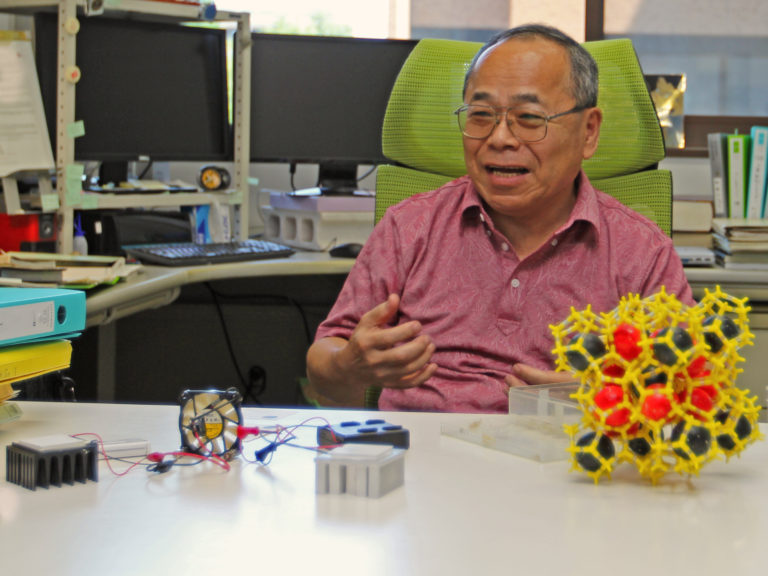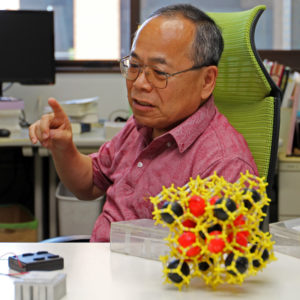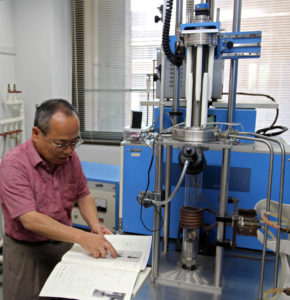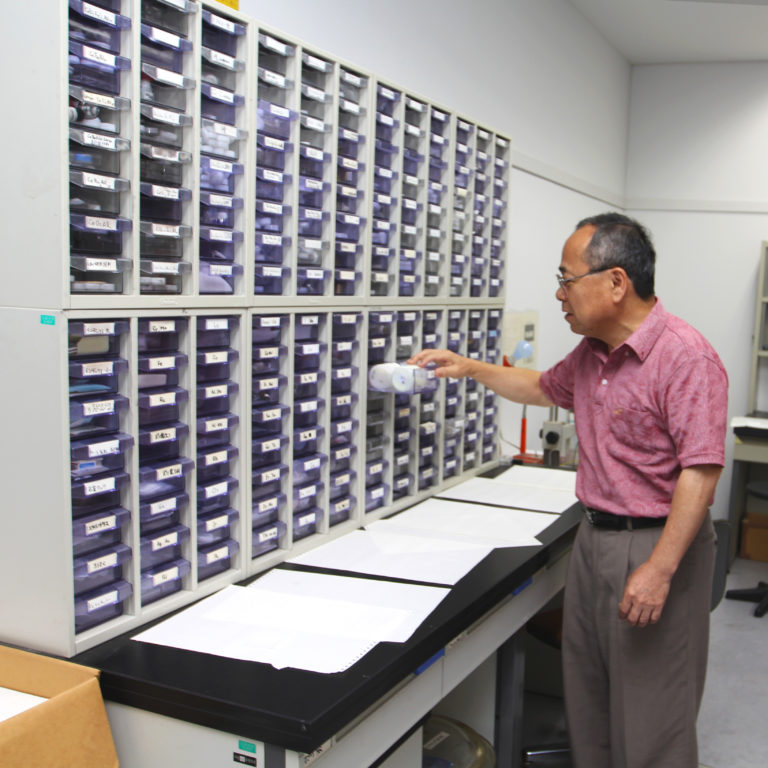On February 1, 2013, Hiroshima University established two new programs: the “Distinguished Professors” (DP) program and the “Distinguished Researchers” (DR) program. Individuals who are part of these programs are recognized as senior and junior faculty members respectively, who are engaged in extraordinarily distinguished research activities.
“This is what we're looking for: a material with low thermal conductivity and high electrical conductivity and that can create a high voltage.
Distinguished Professor Toshiro Takabatake lists the facts of his research without special emphasis, relaxed in his office at Hiroshima University. He joined the university originally in 1988 when much of the faculty was still based at the Hiroshima city campus. He relocated to the new main campus in Saijo during the 1990s and moved between two other departments before settling in the Graduate School of Advanced Sciences of Matter in 1998. He has hosted many international students and faculty over the years. At the time of the interview, a visiting professor from the UK was running some final experiments before the end of his two-month research visit.That same scientist had been a post-doctoral researcher in Takabatake's lab nineteen years previously. Beginning in 2001, Takabatake led a team of 13 other researchers at Hiroshima University in a Center of Excellence research project made possible by a five-year, ¥ 680 million (approximately USD $ 5.6 million) grant from the Japanese government. His leadership from that program yielded positive results and eventually led to his nomination to serve as the Dean of the Graduate School of Advanced Sciences of Matter for four years from 2011 through 2015.

Takabatake has been a faculty member of Hiroshima University since 1988 and served as Dean of the Graduate School of Advanced Sciences of Matter from 2011 to 2015.
“Such kind of duties are really political work.It causes so much stress. No, thank you. So, I finished all of these responsibilities and now I am free,” Takabatake says, laughing and clapping his hands to celebrate.
This freedom has allowed him to return to the work he prefers: synthesizing crystals of novel materials.
“I am often in the laboratory now and I feel very healthy doing this work. If I obtain a good crystal, then more people will join our research for good collaborations. There are always many troubles when preparing crystals, but, eventually, I can say, 'Success!'. ”
The crystals are new compounds of chemicals that may one day become the material he has spent most of his career searching for: something that can conduct electricity without also conducting heat. Researchers have not yet found a naturally occurring material with these properties, and the combination does seem unnatural. Copper wire conducts electricity in power lines and copper cooking pots conduct heat. Rubber does the opposite in both cases. Generally, the same movement of atoms that allows a material to conduct electricity also allows the material to conduct heat. The goal of Takabatake’s work is to identify a material that only conducts electricity, which researchers call a thermoelectric material. Devices built with thermoelectric materials could be used to transform waste heat into electricity by attaching a block of the material to a heat source and then connecting the device to any electrically powered machine.
This heat-to-electricity conversion occurs because of one of the laws of thermodynamics: heat flows from hot to cold, which is why ice in a drink melts into the surrounding liquid rather than slowly freezing the rest of the drink solid. The electrons in the thermoelectric material will constantly move from the hot side to the cold side and flowing electrons create an electrical current. The essential factor to keep current flowing within a thermoelectric generator is that the two sides of the thermoelectric material must remain different temperatures. Therefore, the material must have low thermal conductivity– it must not change temperature easily.
“I teach one undergraduate class for science students who are not majoring in physics. This is my challenge– how to teach when they are not so interested in physics. That is why I have these tools,” says Takabatake, pulling out a small thermoelectric generator, shaped as a box about the size of a Rubik’s cube attached via two wires to a miniature fan. On top of the box is a thin sheet of thermoelectric material.
“When you touch this material on the top of this box, it gets warm from your hand. The material is a thermoelectric generator, so it turns the heat into electricity and powers the fan. It has no battery, no plug.”
If the material on the top of the box were normal metal, the metal would initially be cold, but body heat would quickly warm it. Soon, there would be no temperature difference between the heat-source-contacting side of the material and the bottom side, so the device could not work as a thermoelectric generator.
Instead, the material is made of chemical compounds containing a class of elements called semiconductors, which have unique electrical properties that enable the physics of not changing temperature. Takabatake has a structural model made of scientists’ version of Legos, commonly used in chemistry classes. “I brought this to my last grant application presentation,” Takabatake explains, lifting a yellow model off a shelf lined with color-coded binders and folders.
The yellow bars representing Tin and Gallium atoms connect a network of open spaces that Takabatake calls cages. Alternating arrangements of the atoms create cages of two different sizes. Black spheres represent Barium atoms inside bigger cages; red spheres represent Barium atoms inside smaller cages. The spheres sit still inside the model, but in reality, the atoms constantly move around within those cages, rattling the structure of the molecule. This rattling disrupts the transfer of heat throughout the yellow network of the molecule, but it does not inhibit the movement of electrons that allow the material to conduct electricity.

Takabatake in his office at Hiroshima University. A chemical model of the thermoelectric crystal Ba8Ga16Sn30 and a miniature thermoelectric device sit on his desk. In the chemical model, yellow represents Tin and Gallium; black and red spheres represent atoms of Barium in different sized “cages ”Within the structure of the molecule.
Takabatake synthesizes crystals like this one and collaborates with researchers with expertise in different analytical methods to evaluate the different physical properties of the crystals, sometimes using the advanced photoemission spectroscopy equipment available at the Hiroshima Synchrotron Radiation Center located on the Hiroshima University campus.
The physics and chemistry are complex, but the mechanics of thermoelectric devices are simple because they require no moving parts.
“You could leave them for 20 or 30 years, or more, without anything breaking or wearing out,” says Takabatake.
That longevity is why the first place to use thermoelectric generators was outer space.Radioisotope thermoelectric generators power deep-space exploration probes that are too far from the sun to rely on solar panels, like Voyager 1 and 2 (launched by NASA in September and August 1977, respectively). The warmth generated by radioactive decay of Plutonium-238 releases heat that thermoelectric converters made of Silicon-Germanium (SiGe) convert to electricity to power the space probes.
Takabatake suggests that on Earth, thermoelectric generators could be used to power safety monitors throughout buildings that are difficult to access, like nuclear power plants. If the temperature inside the facility ever rose, the heat would suddenly provide power to a thermoelectric generator that would then turn on an alert signal to notify safety personnel of a potential problem. The same concept of heat turning on a thermoelectrically powered alarm could be used to make home fire alarms that never need replacement batteries.
The potential heat source for a thermoelectric generator can be anything that is warm: car exhaust pipes, ceramic or glass furnaces, or any factory with a smoke or steam chimney. Futuristic wearable electronics could be battery-free by converting body heat into electricity.
Current thermoelectric materials have limited efficiency; only five to nine percent of the heat they absorb becomes electrical energy. Takabatake explains that industrial companies are not yet installing thermoelectric generators onto their furnaces or smokestacks because the cost-vs-benefit remains unfavorable.
Complicating the research is the fact that the search for an efficient thermoelectric material is not a search for just one material. What works for industrial furnaces will not work for wearable electronics. Although the principles of physics are the same, the chemistry and the logistics are different.
“Some chemicals evaporate at high temperatures, and people will not wear heavy, thick materials that are OK for a furnace.I think the next revolution in thermoelectric materials will be to use environmentally friendly materials that do not rely on rare or expensive chemical compounds. Thermoelectricity can improve the environment by increasing energy efficiency, so thermoelectric devices should also be built from materials that are good for the environment, ”says Takabatake.
Takabatake's passion for synthesizing crystals came indirectly, but eventually led him directly to Hiroshima University.He earned his Bachelor and PhD degrees from Kyoto University before going to KFA Forschungszentrum (Nuclear Research Center) in Jülich, Germany and Ruhr-Universität in Bochum, Germany from 1981 to 1984 through the Alexander von Humboldt fellowship program.
“Well, at that time it was West Germany,” remarks Takabatake.
His PhD and post-doc work focused on superconductivity, the ability of certain materials to conduct electricity without any wasted energy.

Takabatake explains how this furnace in his laboratory is used to synthesize novel chemical compounds.
“We used to think that superconductivity and magnetism could not be related. My work was trying to understand why superconductivity happens only in certain materials.”
After returning to Japan, he took a Research Associate position at The Institute for Solid State Physics at the University of Tokyo and continued with the same research specialty.
“My chief said to me one day, ‘You are always doing what I tell you. You are not an independent researcher. Go and find some new material without asking me.’ I thought he was very strange, but he was very right. Because he said this to me, I prepared some compounds now called Kondo Semiconductors.”
These compounds, based on rare-earth elements, conduct electricity differently than metals due to unique activity of their electrons, explained by quantum physics.
In 1986, while Takabatake was teaching himself to synthesize Kondo Semiconductors, researchers working in Switzerland made a breakthrough in superconductivity at high temperatures. Soon afterwards, the role of magnetic activity in copper-oxide superconductors was revealed. The intense surge of interest in the field made Takabatake decide to begin an independent career focusing on some other aspect of materials physics.
“I thought, that competition is not my playground. I will work in a more relaxed field.”
The fundamental question of his work stayed the same: what causes magnetism? Scientists can define magnetism, they can measure it and manipulate it, but the root causes of what causes atoms organize into the specific arrangements that make a material magnetic remains a mystery. “We can add pressure or change temperature, but this is not the answer,” says Takabatake.
“Hiroshima University has a long history in the field of magnetism and crystal growth, so all of the knowledge and techniques were here.”
Leading a tour of his experimental space, he opens the door and flicks on the hidden light switch in a single, habitual motion before briefly pausing. “On no! Today this room is a little bit dirty. The students have left their books,” says Takabatake, spotting a single notebook left open on a table in the large, fastidiously organized lab.
Small areas of the walls are decorated with hand-drawn sketches and some old group photos. Takabatake points to one of the photos. Two of them are post-docs from Brazil who came in 2003, now both professors at a university in their country. They know very well how to enjoy life! So very energetic! ”

Takabatake finds one of the crystals synthesized in his laboratory, stored in one of many sets of drawers.
Takabatake is quietly proud of this large international network of researchers that he has built throughout his career. This networking prowess and his scientific success makes him a good role model for young researchers.
“I was asked to give a seminar next week to PhD students and young researchers about my career. When you start to get these requests, you know it is time to think about the end of your career,” he says, shrugging.
Instead, Takabatake is still thinking about all the things he wants his work to accomplish. He points at a wall in the direction of the incinerator chimney on the North edge of campus. The top of the chimney supports a sign with the university name and logo that lights up in bright green every evening.
“My goal is one day to have that sign be powered with thermoelectricity using a material that I help create,” says Takabatake, still exuding the motivation that brought him to Hiroshima University nearly three decades earlier.

The gray pillar in the right side of the image is the chimney on Hiroshima University's main campus that Takabatake hopes will one day include a thermoelectric generator developed using his research.

 Home
Home